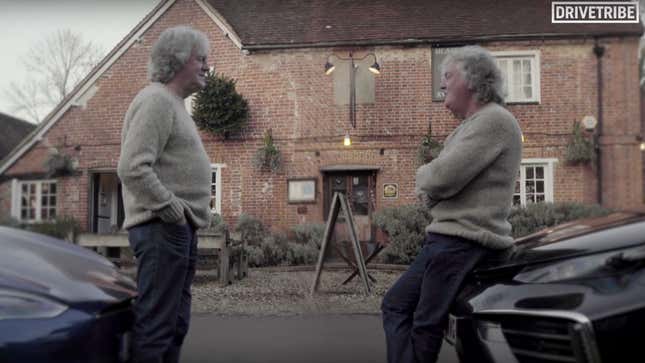
Of the Three Amigos, I’ve always found James May to be the most progressive. His interests are wide-ranging and he usually appears to be quite open-minded on camera. Today, I learned May owns both a Tesla Model S and a Toyota Mirai and he brings up a great point about how we will talk about cars as more get electrified.
On a recent video uploaded to the DriveTribe (remember DriveTribe?) YouTube page, May reviews both of his electric cars and then gets a little philosophical at the end. He finds the Tesla fast but the its screen a little distracting. He finds the Mirai “esoteric,” more refined but also very slow. But it’s more than that, however, he asserts.
The Tesla’s “power is over 400 bhp. Naught to 60 takes a fraction over four seconds—but let’s not get bogged down in those old, 20th-century ways of measuring performance,” he says. “It’s not top speed or naught to 60 or anything like that. It’s kilowatts and updates of software and how much I paid for my last session and where I was.”
He’s right. People like us—enthusiasts—will always care about zero to 60 times and top speeds, but regular consumers have never and will never give a shit. They’ll care about stuff like range and cost of charging and how long that charging takes.
May, being thorough, takes his cars to the charging and hydrogen station (I guess they have more accessible ones in the UK!). The Model S, after 15 minutes of being plugged into a Tesla Supercharger, gained an extra 43 miles of range for £3.38 ($4.43). The Mirai took 1.2 kilograms of hydrogen, which equals about 65 to 70 miles of range, in about two minutes for £14.40 ($18.86).
And then, he has an argument with himself, weighing the pros and cons of both battery-electric and hydrogen fuel cell-electric. Ultimately, he believes there’s room in the market for both of them, but he also believes hydrogen is still in its infancy.
It’s true that hydrogen is currently expensive and energy-intensive to gather and store. It’s true that the storage systems can be improved. There’s still a lot of work to be done to make hydrogen cars, producing hydrogen and the cost of everything much cheaper and more efficient. But it’s starting.
Take a look at the video below.